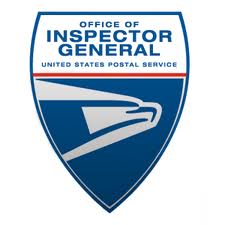The USPS Office of Inspector General reviewed the postal service’s response to the COVID 19 pandemic, and issued the following findings and recommendations:

While we recognize the challenges facing the Postal Service during the pandemic, we identified three areas where the Postal Service can better protect its employees: (1) face covering policy, (2) contact tracing program, and (3) employee health screening.
First, Postal Service employees did not always wear face coverings when proper social distancing could not be achieved. We visited 10 facilities, including five mail processing and five retail and delivery facilities, and observed employees at four retail and delivery facilities (40 percent) who did not adhere to the local face covering policy. In addition, during our review of camera footage, we observed 41 of 117 facilities (35 percent) with at least one employee not wearing a face covering where a local mandate required one, and while not social distancing.
These employees were behind the counter or in the back of a retail and delivery facility or on the workroom floor in a processing facility.
The Postal Service face covering policy at all facilities cited local or state mandates and when employees could not maintain social distancing in the workplace. However, facility management voiced confusion with the policy and interpreted it to mean that state and local directives determined whether employees were required to wear face coverings. Postal Service Headquarters considered the local requirements supplemental to the nationwide policy.
In addition, managers of offending employees were not always aware they could enforce the face covering policy. An enforcement process which includes engaging the union representative and taking appropriate action existed; however, it was not well-known or followed because it was only communicated verbally to some managers. The confusing face covering policy and its inconsistent enforcement put employees at a higher risk of exposure to COVID-19 and potentially decreased employee availability.
Second, the Close Contact Tracing Program did not include an overarching program goal with associated metrics and did not ensure adequate staffing. Management indicated they did not establish goals for the contact tracing program because they did not believe contact tracing was measurable and did believe that its application varied case by case. However, program goals and performance metrics are essential to monitor progress and determine resources needed. In addition, the responsibilities of and reliance on the nursing staff grew during the pandemic because local public health departments were unable to complete contact tracing. As of July 31, 2020, there were 116 Postal Service nurses nationwide, with 30 vacancies — a 21 percent vacancy rate. Local management did not actively post open positions on the Postal Service’s career website. Retaining a full complement of nurses, or supplementing them where necessary with contractor support, is especially important during the COVID-19 crisis.
Lastly, although the CDC recommended temperature taking for employees in April 2020, the Postal Service did not deploy temperature taking within its facilities nationwide. As of July 31, 2020, there was at least one employee who either tested positive for COVID-19 or quarantined due to possible exposure to the virus at over 7,000 Postal Service facilities. The Postal Service conducted a temperature taking proof of concept test in May 2020 at four facilities, and it plans to conduct health screening tests at two additional facilities.
The Postal Service indicated that it has not deployed nationwide temperature taking tests because completing the test is resource intensive and there were privacy concerns. The Postal Service’s process for conducting the tests was complicated, and it required the purchase of different types of thermometers, additional employee time, and coordination with the law department and unions. Additionally, the Postal Service determined that temperature taking alone would not be enough to identify employees with COVID-19. Without conducting daily in-person or virtual health checks of employees before they enter the facility, employees could come to work while sick, increasing the likelihood of transmission of COVID-19 to other employees and customers.
We did not evaluate recent operational changes made by the Postal Service or the significant increases in delayed mail at delivery units experienced this summer. In response to a congressional request received on August 7, 2020, we have an ongoing project which will evaluate these operational changes and their impact on mail service.
Recommendations
We recommended management:
- Clarify and communicate the Postal Service’s face covering policy for consistent, nationwide application.
- Communicate policy regarding immediate enforcement and corrective action for non-compliance with the face covering policy.
- Re-evaluate the Close Contact Tracing Program to include program goals, performance metrics, and a hiring initiative to ensure adequate staffing.
- Evaluate options and implement a nationwide health screening initiative which may include employee self-certification.
Source: Employee Safety – Postal Service COVID-19 Response | USPS Office of Inspector General